Acer AO1-431, AO1-431M User Manual
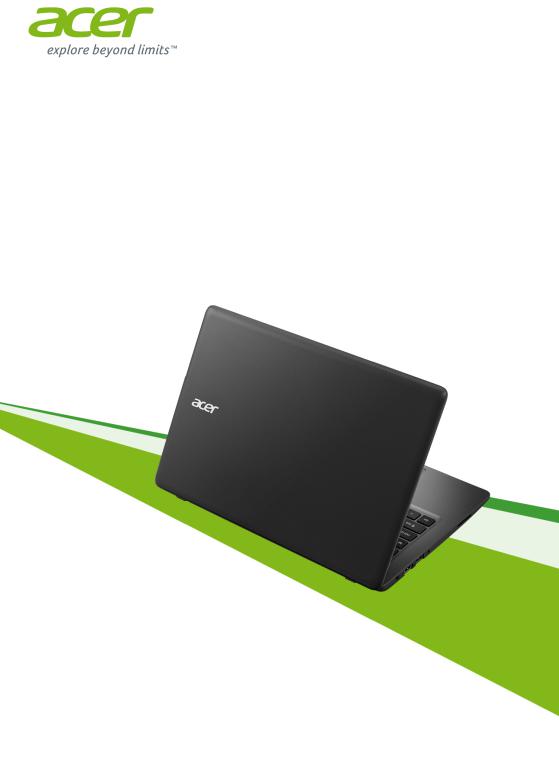
Aspire One Cloudbook 14
User’s Manual

2 -
© 2015. All Rights Reserved. Aspire One Cloudbook 14 Covers: AO1-431 / 1-431M This revision: August 2015
Sign up for an Acer ID and enjoy great benefits
Open the Acer Portal app to sign up for an Acer ID or sign in if you already have an Acer ID.
There are three great reasons for you to get an Acer ID:
•Build Your Own Cloud with Acer BYOC.
•Get the latest offers and product information.
•Register your device for warranty service.
For more information, please visit the Acer BYOC website:
www.acer.com/byoc-start
Important
This manual contains proprietary information that is protected by copyright laws. The information contained in this manual is subject to change without notice. Images provided herein are for reference only and may contain information or features that do not apply to your computer. Acer Group shall not be liable for technical or editorial errors or omissions contained in this manual.
Model number: _________________________________
Serial number: _________________________________
Date of purchase: ______________________________
Place of purchase: ______________________________

Table of contents - 3
TABLE OF CONTENTS
First things first |
5 |
Your guides ............................................. |
5 |
Basic care and tips for using your |
|
computer.................................................. |
5 |
Turning your computer off........................... |
5 |
Taking care of your computer ..................... |
6 |
Taking care of your AC adapter .................. |
6 |
Cleaning and servicing................................ |
7 |
Your Acer notebook tour |
8 |
Screen view ............................................. |
8 |
Keyboard view ......................................... |
9 |
Left view ............................................... |
10 |
Information on USB 3.0............................. |
10 |
Right view ............................................. |
11 |
Base view .............................................. |
11 |
Using the keyboard |
12 |
Lock keys and embedded numeric |
|
keypad ................................................... |
12 |
Hotkeys ..................................................... |
13 |
Windows keys........................................ |
14 |
Touchpad |
15 |
Touchpad basics ................................... |
15 |
Touchpad gestures................................ |
15 |
Charging the battery ................................. |
31 |
Optimizing battery life ............................... |
32 |
Checking the battery level......................... |
33 |
Battery-low warning .................................. |
33 |
Traveling with your computer |
34 |
Disconnecting from the desktop ............ |
34 |
Moving around ....................................... |
34 |
Preparing the computer ............................ |
34 |
What to bring to meetings ......................... |
35 |
Taking the computer home .................... |
35 |
Preparing the computer ............................ |
35 |
What to take with you................................ |
36 |
Special considerations .............................. |
36 |
Setting up a home office ........................... |
36 |
Traveling with the computer................... |
37 |
Preparing the computer ............................ |
37 |
What to take with you................................ |
37 |
Special considerations .............................. |
37 |
Traveling internationally......................... |
37 |
Preparing the computer ............................ |
38 |
What to bring with you .............................. |
38 |
Special considerations .............................. |
38 |
Memory card reader |
40 |
Connectivity options............................... |
40 |
Video and audio connectors |
42 |
Using a Bluetooth connection |
17 |
Universal Serial Bus (USB) |
43 |
Enabling and disabling Bluetooth .......... |
17 |
Enable Bluetooth and add a device .......... |
17 |
Connecting to the Internet |
19 |
Connecting to a wireless network.......... |
19 |
Connecting to a wireless LAN................... |
19 |
Connecting with a cable ........................ |
23 |
Built-in network feature ............................. |
23 |
Connecting to a cellular network ........... |
23 |
Acer Bluelight Shield |
24 |
Securing your computer |
26 |
Using passwords ................................... |
26 |
Entering passwords .................................. |
26 |
BIOS utility |
28 |
Boot sequence....................................... |
28 |
Setting passwords ................................. |
28 |
HDMI |
44 |
Frequently asked questions |
46 |
Requesting service ................................ |
48 |
Tips and hints for using Windows 10 ..... |
49 |
How do I get to Start? ............................... |
49 |
How do I turn off my computer?................ |
49 |
How do I unlock my computer?................. |
49 |
How do I set the alarm? ............................ |
51 |
Where are my apps?................................. |
52 |
What is a Microsoft ID (account)?............. |
52 |
How do I check for Windows updates?..... |
53 |
Where can I get more information?........... |
53 |
Troubleshooting ..................................... |
54 |
Troubleshooting tips.................................. |
54 |
Error messages......................................... |
54 |
Internet and online security |
56 |
First steps on the net ............................. |
56 |
Power management |
29 |
Saving power......................................... |
29 |
Battery pack |
31 |
Battery characteristics ........................... |
31 |
Protecting your computer.......................... |
56 |
Choose an Internet Service Provider ........ |
56 |
Network connections................................. |
58 |
Surf the Net!.............................................. |
60 |
Security ..................................................... |
60 |

Getting started...
In this section you will find:
•Useful information on caring for your computer and your health
•Where to find the power button, ports and connectors
•Tips and tricks for using the touchpad and keyboard
•How to create recovery backups
•Guidelines for connecting to a network and using Bluetooth
•Information on using Acer’s bundled software

First things first - 5
FIRST THINGS FIRST
We would like to thank you for making this Acer notebook your choice for meeting your mobile computing needs.
Your guides
To help you use your Acer notebook, we have designed a set of guides:
First off, the Setup Guide (or Setup Poster) helps you get started with setting up your computer.
The Quick Guide introduces you to the basic features and functions of your new computer. For more on how your computer can help you to be more productive, please refer to the User’s Manual. This guide contains detailed information on such subjects as system utilities, data recovery, expansion options and troubleshooting.
To download the User’s Manual, you must first be connected to the internet. Open Acer Care Center from the desktop and click on the link under Support. The link will open the Acer Service & Support webpage. Scroll down to Drivers and Manuals and search for your model by entering the serial number, SNID, or product model. You may also download and install the Acer identification tool that will automatically detect this information and allow you to copy it to the clipboard. Once you have found your product model, select Documents and select your language to download the User’s Manual.
Basic care and tips for using your computer
Turning your computer off
To turn the power off, do any of the following:
•Use the Windows shutdown command: Press the Windows key or select the Windows Start button, select Power > Shut down.
•Right-click the Windows Start button > Shut down or sign out >
Shut down.

6 - First things first
If you need to power down the computer for a short while, but don’t want to completely shut it down, you can put it to Sleep by doing any of the following:
•Press the power button.
•Press the sleep hotkey <cross-ref to keyboard section>.
•Press the Windows key or select the Windows Start button, select
Power > Sleep.
•Right-click the Windows Start button > Shut down or sign out >
Sleep.
Note
If you cannot power off the computer normally, press and hold the power button for more than four seconds to shut down the computer. If you turn off the computer and want to turn it on again, wait at least two seconds before powering up.
Taking care of your computer
Your computer will serve you well if you take care of it.
•Do not expose the computer to direct sunlight. Do not place it near sources of heat, such as a radiator.
•Do not expose the computer to temperatures below 0º C (32º F) or above 50º C (122º F).
•Do not subject the computer to magnetic fields.
•Do not expose the computer to rain or moisture.
•Do not spill water or any liquid on the computer.
•Do not subject the computer to heavy shock or vibration.
•Do not expose the computer to dust or dirt.
•Never place objects on top of the computer.
•Do not slam the computer display when you close it.
•Never place the computer on uneven surfaces.
Taking care of your AC adapter
Here are some ways to take care of your AC adapter:
• Do not connect the adapter to any other device.
First things first - 7
•Do not step on the power cord or place heavy objects on top of it. Route the power cord and any cables away from where people walk.
•When unplugging the power cord, do not pull on the cord itself but pull on the plug.
•The total ampere ratings of the equipment plugged in should not exceed the ampere rating of the cord if you are using an extension cord. Also, the total current rating of all equipment plugged into a single wall outlet should not exceed the fuse rating.
Cleaning and servicing
When cleaning the computer, follow these steps:
1.Turn off the computer.
2.Disconnect the AC adapter.
3.Use a soft, moist cloth. Do not use liquid or aerosol cleaners.
If your computer is dropped or visibly damaged, or does not work normally, please contact your nearest authorized Acer service center. For more information, please See Frequently asked questions on page 46.
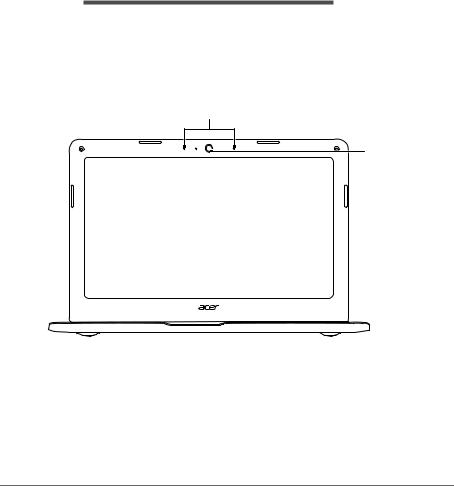
8 - Your Acer notebook tour
YOUR ACER NOTEBOOK TOUR
After setting up your computer as illustrated in the Setup Guide, let us show you around your new Acer computer.
Screen view
1
2
# |
Icon Item |
Description |
|
1 |
Microphones |
Internal stereo microphones for |
|
sound recording. |
|||
|
|
||
|
|
Web camera for video |
|
2 |
Webcam |
communication. |
|
A light next to the webcam indicates |
|||
|
|
that the webcam is active.
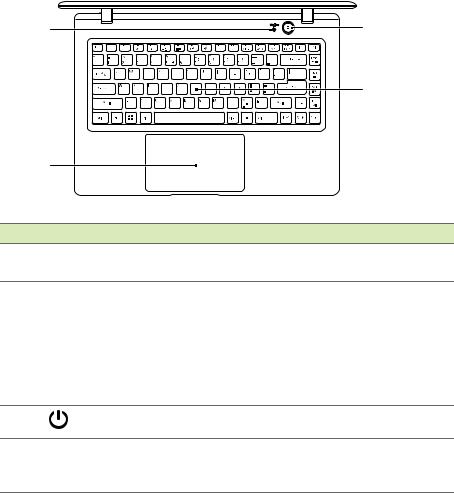
|
|
Your Acer notebook tour - 9 |
Keyboard view |
|
|
|
1 |
3 |
|
|
4 |
|
2 |
|
# |
Icon Item |
Description |
1 |
Power indicator |
Indicates the computer’s power |
status. |
||
|
|
Touch-sensitive pointing device. |
|
|
The touchpad and selection buttons |
|
|
form a single surface. |
2 |
Touchpad |
Press down firmly on the touchpad |
|
|
surface to perform a left click. |
|
|
Press down firmly on the lower right |
|
|
corner to perform a right click. |
3 |
Power button |
Turns the computer on and off. |
|
|
For entering data into your computer. |
4 |
Keyboard |
See "Using the keyboard" on page |
|
|
12. |
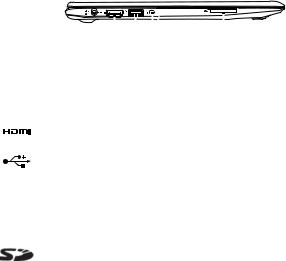
10 - Your Acer notebook tour
Left view
|
|
|
|
|
|
|
|
|
|
|
|
|
|
|
|
|
|
|
|
|
|
|
1 |
2 |
3 4 |
5 |
||||||
|
|
|
|
|
|
|
|
|||
# |
Icon Item |
|
|
|
|
|
Description |
|||
1 |
DC-in jack |
|
|
|
Connects to an AC adapter. |
|||||
2 |
HDMI port |
|
|
|
Supports high-definition digital video |
|||||
|
|
|
connections. |
|||||||
|
|
|
|
|
|
|
|
|
||
3 |
USB port |
|
|
|
|
|
Connects to USB devices. |
|||
|
Headset/ |
|
|
|
|
|
Connects to audio devices (e.g., |
|||
4 |
|
|
|
|
|
speakers, headphones) or a headset |
||||
speaker jack |
|
|
|
|||||||
|
|
|
|
with microphone. |
||||||
|
|
|
|
|
|
|
|
|
||
|
|
|
|
|
|
|
|
|
|
|
|
|
|
|
|
|
|
|
|
Accepts one Secure Digital (SD or |
|
5 |
SD card reader |
SDHC) card. |
||||||||
|
|
|
|
|
|
|
|
|
Only one card can operate at a time. |
|
Information on USB 3.0
•USB 3.0 compatible ports are blue.
•Compatible with USB 3.0 and earlier devices.
•For optimal performance, use USB 3.0-certified devices.
•Defined by the USB 3.0 specification (SuperSpeed USB).
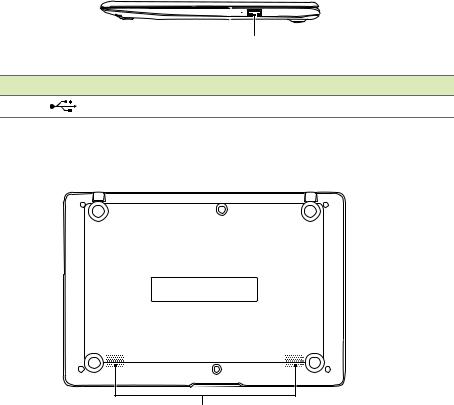
Your Acer notebook tour - 11
Right view
|
|
1 |
# |
Icon Item |
Description |
1 |
USB port |
Connects to USB devices. |
Base view
|
|
1 |
|
|
|
# |
Icon Item |
Description |
1 |
Speakers |
Deliver stereo audio output. |

12 - Using the keyboard
USING THE KEYBOARD
The keyboard has full-sized keys and an embedded numeric keypad, separate cursor, lock, Windows, function and special keys.
Lock keys and embedded numeric keypad
The keyboard has three lock keys which you can toggle on and off.
|
|
|
Lock key |
Description |
|
Caps Lock |
When Caps Lock is on, all alphabetic characters |
|
typed are in uppercase. |
||
|
When Num Lock is on, the embedded keypad is in numeric mode. The keys function as a calculator
Num Lock (complete with the arithmetic operators +, -, *, and /). <Fn> + <F11> Use this mode when you need to do a lot of numeric
data entry. A better solution would be to connect an external keypad.
When Scroll Lock is on, the screen moves one line up Scroll Lock or down when you press the up or down arrow keys <Fn> + <F12> respectively. Scroll Lock does not work with some
applications.
The embedded numeric keypad functions like a desktop numeric keypad. It is indicated by small characters located on the upper right corner of the keycaps. To simplify the keyboard legend, cursor-control key symbols are not printed on the keys.
|
|
Num Lock off |
|
Desired access |
Num Lock on |
||
Number keys on |
Type numbers in a normal |
|
|
embedded keypad |
manner. |
|
|
Cursor-control keys |
Hold <Shift> while using |
Hold <Fn> while |
|
on embedded |
cursor-control keys. |
using cursor-control |
|
keypad |
keys. |
||
|
|||
Main keyboard |
Hold <Fn> while typing |
Type the letters in a |
|
letters on embedded |
|||
keys |
normal manner. |
||
keypad. |
|||
|
|
||
|
|
|

Using the keyboard - 13
Hotkeys
The computer employs hotkeys or key combinations to access most of the computer's controls like screen brightness and volume output.
To activate hotkeys, press and hold the <Fn> key before pressing the other key in the hotkey combination.
|
|
|
|
|
|
|
|
Hotkey |
Icon |
Function |
Description |
||||
<Fn> + <F3> |
Airplane mode |
Turns on / off the computer's |
|||||
network devices. |
|||||||
<Fn> + <F4> |
Sleep |
Puts the computer in Sleep |
|||||
mode. |
|||||||
|
|
|
|
|
|
||
|
|
|
|
|
|
Switches display output |
|
<Fn> + <F5> |
Display toggle |
between the display screen, |
|||||
external monitor (if |
|||||||
|
|
|
|
|
|
||
|
|
|
|
|
|
connected) and both. |
|
|
|
|
|
|
|
|
|
<Fn> + <F6> |
|
Turns the display screen |
|||||
Display off |
backlight off to save power. |
||||||
|
|
|
|
|
|
Press any key to return. |
|
<Fn> + <F7> |
Touchpad |
Turns the built-in touchpad on |
|||||
toggle |
and off. |
||||||
|
|
|
|
|
|||
<Fn> + <F8> |
Speaker toggle |
Turns the speakers on and |
|||||
off. |
|||||||
<Fn> + <F11> |
NumLk |
Turns the embedded numeric |
|||||
keypad on or off. |
|||||||
|
|
|
|
|
|
||
<Fn> + <F12> |
Scr Lk |
Turns the scroll lock feature |
|||||
on or off. |
|||||||
|
|
|
|
|
|
||
<Fn> + < |
> |
|
|
|
Brightness up |
Increases the screen |
|
|
|
|
brightness. |
||||
|
|
|
|
|
|
||
<Fn> + < |
> |
|
|
|
Brightness |
Decreases the screen |
|
|
|
|
down |
brightness. |
|||
|
|
|
|
|
|||
<Fn> + < |
> |
|
|
|
Volume up |
Increases the sound volume. |
|
|
|
|
|
|
|
|
|
<Fn> + < |
> |
|
|
|
Volume down |
Decreases the sound volume. |
|
|
|
|
|
|
|
|
|
<Fn> + |
|
|
|
|
Play/Pause |
Play or pause a selected |
|
<Home> |
|
|
|
|
media file. |
||
|
|
|
|
|
|||
<Fn> + |
|
|
|
|
Stop |
Stop playing the selected |
|
<Pg Up> |
|
|
|
|
media file. |
||
|
|
|
|
|
|||

14 - Using the keyboard |
|
|
|
|
|
|
|
|
|
|
|
|
Hotkey |
Icon Function |
Description |
||
|
<Fn> + |
|
|
Previous |
Return to the previous media |
|
<Pg Dn> |
|
|
file. |
|
|
|
|
|
||
|
<Fn> + |
|
|
Next |
Jump to the next media file. |
|
<End> |
|
|
||
|
|
|
|
|
|
Windows keys
The keyboard has two keys that perform Windows-specific functions.
Key Description
Pressed alone it returns to the Start screen or to
Windows key return to the last open app.
It can also be used with other keys for special functions, please check Windows Help.
Application |
This key has the same effect as clicking the right |
|
mouse button; it opens the application's context |
||
key |
||
menu. |
||
|
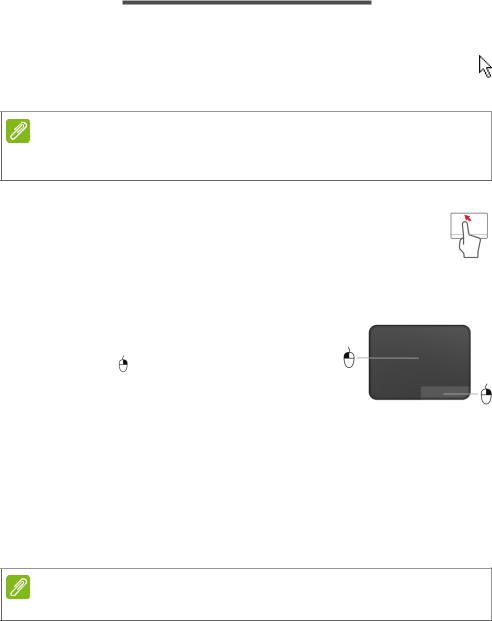
Touchpad - 15
TOUCHPAD
Touchpad basics
The touchpad controls the arrow (or 'cursor') on the screen. As you slide your finger across the touchpad, the cursor will follow this movement.
Note
The touchpad is sensitive to finger movement; the lighter the touch, the better the response. Please keep the touchpad and your fingers dry and clean.
The cursor is controlled by some basic gestures:
•Single-finger slide: Slide a finger across the touchpad to move the cursor.
•Single-finger press or tap: Press the touchpad down, or lightly tap the touchpad with your finger, to perform a 'click',
which will select or start an item. Quickly repeat the tap to perform a double tap or 'double click'.
•Single-finger press in the bottom-right corner: Press the bottom right corner of the
touchpad to perform a 'right click'. In the Start screen, this will toggle the app commands, in most apps this will open a context menu related to the selected item.
•Drag: Press and hold the bottom left corner of the touchpad, or tap twice anywhere on the touchpad, then slide a second finger across the touchpad to select all items in an area.
Touchpad gestures
Many applications support touchpad gestures that use one or more fingers.
Note
Support for touchpad gestures depends on the active application.
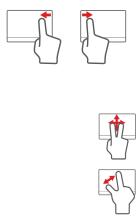
16 - Touchpad
This allows you to control applications with a few simple gestures, such as:
•Swipe in from edge: Access Windows tools by swiping into the center of the touchpad from the right or left edge.
•Swipe in from right: Open the Action Center.
•Swipe in from left: Switch to the previous app.
•Two-finger slide: Swiftly scroll through web pages, documents and playlists by placing two fingers on the touchpad and moving both in any direction.
•Two-finger pinch: Zoom in and out of photos, maps and documents with a simple finger-and-thumb gesture.

Using a Bluetooth connection - 17
USING A BLUETOOTH CONNECTION
Bluetooth is a technology enabling you to transfer data wirelessly over short distances between many different types of devices. Bluetoothenabled devices include computers, cell phones, tablets, wireless headsets, and keyboards.
To use Bluetooth, you must ensure the following:
1.Bluetooth is enabled on both devices.
2.Your devices are "paired" (or connected).
Enabling and disabling Bluetooth
The Bluetooth adapter must be enabled on both devices. For your computer, this may be an external switch, a software setting, or a separate Bluetooth dongle plugged into the computer’s USB port (if no internal Bluetooth adapter is available).
Note
Please check your devices owner’s manual to determine how to turn on its Bluetooth adapter.
Enable Bluetooth and add a device
Every new device must first be "paired" with your computer’s Bluetooth adapter. This means it must first be authenticated for security purposes. You only need to pair once. After that, simply turning on the Bluetooth adapter of both devices will connect them.
Bluetooth on your computer is disabled by default. To enable your computer’s Bluetooth adapter, do the following:
1.Press the Windows key or select the Windows Start button >
Settings > Devices > Bluetooth, and click the toggle under Bluetooth to enable/disable it.
2.Your computer will automatically start searching for devices, as well as make itself visible to other devices.
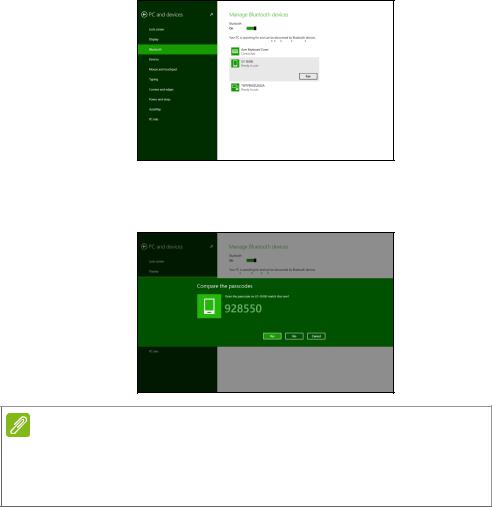
18 - Using a Bluetooth connection
3.Select the device you wish to pair from the list of discovered devices, and select Pair.
4.A code displays on your computer, which should match the code displayed on your device. Select Yes. Then, accept the pairing from your device.
Note
Some devices using older versions of the Bluetooth technology require both devices to enter a PIN. In the case of one of the devices not having any inputs (as in a headset), the passcode is hardcoded into the device (usually "0000" or "1234"). Consult your device’s user manual for more information.
You can also enter the Bluetooth settings by selecting the Notifications icon in the lower right-hand corner of the screen to open the Notifications pane. From here, you can enable or disable Bluetooth or right-click on Bluetooth > Go to settings to enter the Bluetooth settings.

Connecting to the Internet - 19
CONNECTING TO THE INTERNET
This chapter includes general information on types of connections, and getting connected to the internet. Some of this information may not apply to your computer. For detailed information, please refer to
Network connections on page 58.
Your computer’s built-in network features make it easy for you to connect your computer to the internet using a cable or a wireless connection.
First though, in order to connect to the internet, you’ll need to sign up for internet services from an ISP (Internet Service Provider) -- usually a phone or cable company -- that will have to go to your home or office to set up internet service. The ISP will install a small box, a router or modem, that will allow you to connect to the internet.
Connecting to a wireless network
Connecting to a wireless LAN
A wireless LAN (or WLAN) is a wireless local area network, which can link two or more computers without using wires. Once connected to WLAN, you can access the internet. You can also share files, other devices, and even your internet connection itself.
Warning
Using wireless devices while flying in aircraft may be prohibited. All wireless devices must be switched off before boarding an aircraft and during take-off, as they may be dangerous to the operation of the aircraft, disrupt communications, and even be illegal. You may turn on your computer’s wireless devices only when informed that it is safe to do so by the cabin crew.
Your computer's wireless connection is turned on by default and Windows will detect and display a list of available networks during setup. Select your network and enter the password if required.
Acer notebook computers feature an Airplane mode hotkey that turns the network connection on or off. You can use the network
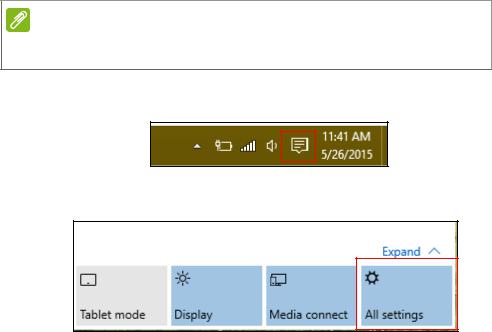
20 - Connecting to the Internet
management options to turn your wireless network on/off or control what is shared over the network.
To connect to a wireless network, please follow the steps below.
1.Ensure you have a wireless router/access point and current internet connection through the ISP of your choice. Make a note of the wireless network’s name and password (if necessary). If you are trying to connect to a public network (such as at a coffeeshop), make sure you have the wireless network’s name.
Note
Please refer to your ISP or router documentation for details on connecting to the internet.
2.In the icon tray in the lower right-hand corner of the screen, select the Notifications icon to open the Notifications pane.
3.Select All settings.
